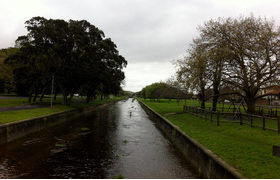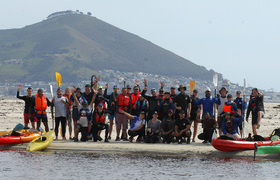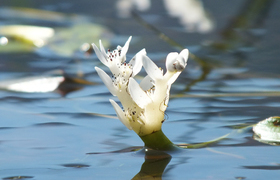Five signs that Day Zero may be averted
23 January 2018 | Story Kevin Winter. Photo James Arnott via Flickr. Read time 7 min.
The message from Patrica de Lille, the mayor of Cape Town, on Thursday, 18 January, was frank and terrifying. She claimed that we had reached the “point of no return” and that Day Zero – when the taps will be turned off – is “now likely to happen”.
Day Zero is currently predicted for 12 April. However, a lot can happen before that day arrives.
The news of the drought crisis has spread across the globe, and the world is now watching and waiting to learn the fate of the city. The City of Cape Town is desperate to avoid a catastrophe – the consequences could be severe for the city. The municipality and the national Department of Water and Sanitation will be held accountable.
There are five signs of progress worth watching that could push Day Zero further out and give the City more time to contain the water crisis. These signs are supported by data found in the City’s summary on the Water Outlook for 2018 and on its water dashboard and weekly dam levels web page.
1. Taps are closing on the agricultural sector
Day Zero has already arrived for many farmers in the Western Cape. Tragically, for some farmers this has happened on the eve of their harvesting period. By the end of January, farmers who are drawing from the Western Cape Water Supply System (WCWSS) will have reached the target usage of 58 million cubic metres and their taps will be closed.
The agriculture sector uses approximately 47% of the WCWSS compared with 48% used by the city of Cape Town. This means that from February onwards there should be more water available for supplying Cape Town itself.
The farmers are giving a gift to the city. The effect of this curtailment will only become known next month, but it could push Day Zero further out.
2. Level 6B restrictions
From 1 February tough new restrictions (Level 6B) will be introduced, and a new water tariff structure will punish wasteful water users with a seven-fold increase in the cost of water.
When the new restrictions are introduced, they will bite hard. The new target for water use will be reduced from the current 500 million litres per day to 450 million litres per day, which equates to 50 litres per person per day.
It won’t be easy to achieve this level – thus far the target of 500 million litres per day has never been met.
In their media release on 18 January, the City claimed that 60% of citizens are not compliant and said that it is taking drastic action to deal with “callous” users in order to avert disaster. And the City does have some control over water demand – if the level of compliance is achieved, it could stretch existing supplies.
At present, residents are using about 350 million litres per day while other sectors, such as commerce, industry, government and large institutions, are using 250 million litres. The new target of 450 million litres is going to be a challenge, but it can’t be up to residents alone. Other sector users will need to do better.
Control over water usage is likely to have the biggest impact in averting Day Zero.
3. New water projects
Seven new water projects are in preparation to augment supplies: four small desalination plants; two projects to abstract water from aquifers; and one project that uses treated effluent. These projects could add anything between 150 and 250 million litres per day to the water supply. They are ambitious projects and they are being implemented in a race against time.
It is expected that the first of these projects – abstractions from aquifers – will be operational by the end of February. Additional supplies will help shift Day Zero further out.
4. It rains
It is too early to predict the regional winter rainfall for 2018, but because we have been disappointed so many times we tend to forget that it still rains in the Western Cape. However, even during the summer months, there are a couple of days of significant (anything over 1 mm) rainfall.
This is inadequate to recharge the main dams, but a light drizzle and cloudy weather conditions help to reduce evaporation loss. Moreover, residents have become increasingly skilled at collecting rainfall and even a small amount can decrease individual demand on the municipal supply.
It might take three years to fully recharge the dams, but it would take only one major thunderstorm over the next 90 days to push Day Zero a little further out.
In April 2005, for example, when the region was also in the grip of a drought, nearly 100 mm of rain fell in the catchment surrounding the Theewaterskloof Dam. The first significant rain thereafter fell only in early July, but that single April thunderstorm saved the day.
5. Trust
Day Zero is not an option.
We will all be very unlucky if we are defeated, but it won’t be for lack of effort. The days of procrastination have given way to plans and projects that deal with both the short-term crisis and a longer-term strategy, which reaches until 2022.
The experience and expertise of City officials in the Department of Water and Sanitation is starting to emerge above the political veneer and rhetoric. In addition, the City is drawing on experienced professionals and consultants who are advising on a range of water management strategies, including technical, financial and policy matters.
There is potential for the City to demonstrate best practice in preparing a city to deal with the sudden onset of climate change.
Robust reporting on progress and weekly updates are likely to allay public fears and build a stronger trust between citizens and City. We expect City officials to be sensible, to carefully assess the risks, and to move swiftly to avoid Day Zero. They too will be held accountable should they fail.
A public commitment
It is time for calm heads.
We need a public commitment to avoid Day Zero and never to allow water resources to compromise the well-being of the Western Cape’s citizens, its economy and ecology again.
In the meanwhile, let’s watch for these five signs of progress – they have the potential to avert the horrible consequences of Day Zero.
 This work is licensed under a Creative Commons Attribution-NoDerivatives 4.0 International License.
This work is licensed under a Creative Commons Attribution-NoDerivatives 4.0 International License.
Please view the republishing articles page for more information.
Cape Town water crisis
At UCT our researchers have been analysing the causes of the current drought, monitoring water usage on campus and in the city, and looking for ways to save water while there is still time. As part of UCT’s water-saving campaign, all members of the campus community are encouraged to reduce their water use by half, which will help Cape Town to meet its water-use goals and ensure a water-sustainable university in the future.



























